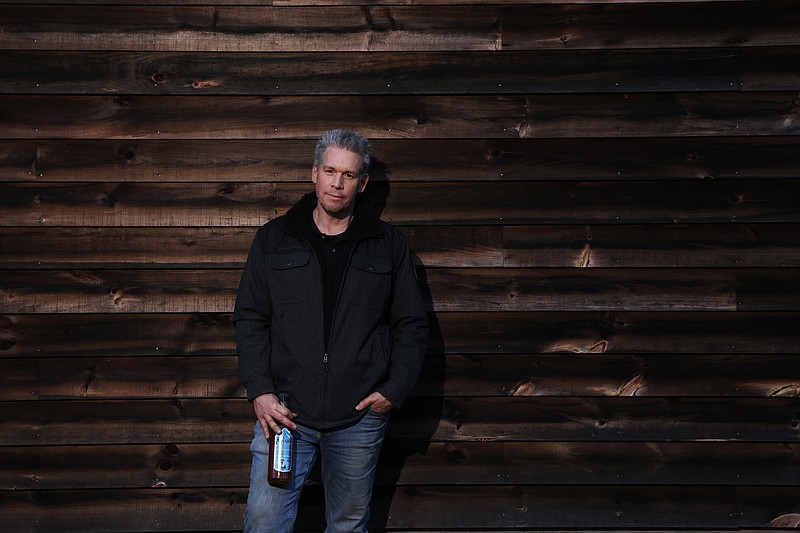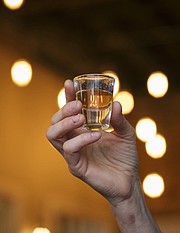MORAVIAN FALLS, N.C . - On the drive up Brushy Mountain through high pine woods, the GPS guidance peters out quickly.
"Take a left at the 'Road Closed Ahead' sign" is the first of many twists and turns that John Holman texts to visitors to his distillery, here at the eastern edge of the Blue Ridge Mountains.
The bridge to the property was washed away by Tropical Storm Eta last November, and the pandemic has discouraged the customers who normally visit to buy his high-proof "waters of life," also known as aquavit, vodka and schnapps.
But Holman still shimmers with energy and pride in his pet project: applejack.
Holman Distillery is one of several new producers, here and in other apple-rich regions, that are reviving this quintessentially American drink - the original moonshine of the colonies - from the death blow it was dealt a century ago by Prohibition.
Holman, 49, is unusual in making applejack in the traditional way, but like other craft distillers, he is nudging it to line up with modern tastes, barrel-aging it to give it the smooth, sippable patina of fine brandy, and tinkering with single-varietal batches to bring out the flavor of heirloom fruit.
Just as long-aged American spirits like Pappy Van Winkle bourbon and Michter's rye have become as desirable as French Cognacs and single-malt Scotch whiskies, the new apple brandies have heritage and flavor enough to build a devoted following.
Applejack was traditionally produced from the hard cider that was the everyday drink for most Americans in the 18th century. Naturally fermented and low in alcohol, hard cider was safer than well water, cheaper than beer and easy to make at home.
In this cool, fertile Appalachian region, apples were then far more plentiful than the grains needed to make whiskey. Up to and through the Prohibition era, there were countless producers making and (illegally) selling applejack in the Blue Ridge Mountains, where roads were limited and trees provided thick cover from government agents.
Local Wilkes County bootleggers like Junior Johnson, the Thomas brothers and the Flock family famously became the first generation of NASCAR drivers in the 1940s and '50s, and many of the sport's first speedways, along with its Hall of Fame, are within 100 miles of here.
The original applejack, which many historians believe was invented by American colonists, was produced by a low-tech method called "jacking." Jacked spirits are distilled not by the usual method of boiling, but by freezing, and any household with a supply of hard cider and cold weather could make applejack.
With each freeze, the water in the cider crystallizes into slushy ice. Each time the ice is skimmed off, the concentration of alcohol grows, until what is left in the barrel reaches about 40 proof. That clear spirit is applejack - not as strong as modern distilled spirits like vodka, but strong enough to last the winter.
Holman's jacking method is a guarded secret, but he is far from the only craft distiller experimenting with applejack (and its aged version, apple brandy) in this region, where apples have long been a staple crop. (As far as federal labeling goes, applejack and apple brandy are one and the same.)
Virginia and the Carolinas are as far south as most apple varieties can grow; they need a certain number of cold nights each year to flourish. It's the land of dried apple hand pies, apple stack cakes, apple cider vinegar and applejack - all ways to preserve fall's fruit for eating and drinking through the winter.
The original applejack was probably cloudy, with bits of peel, bees, leaves and whatever else stumbled in over the course of the winter. The new versions of applejack - from producers like Catoctin Creek, Holman Distillery and Copper & Kings - range from clear to deep auburn liquors.
The local craft-cocktail crowd has embraced the new apple brandies in classics like the Jack Rose, the Widow's Kiss and old-fashioned. Creative bartenders like Drew Furlough, of District 42 restaurant in nearby Asheville, are building new drinks around them.
As microcideries open on farms, in cities and within microbreweries, hard cider and applejack are developing a stronger infrastructure, producers say. But distilleries that make high-proof spirits remain heavily regulated at both the federal and state level.
Scott and Becky Harris opened Catoctin Creek in Purcellville, Virginia, in 2009. Whiskeys are their main product, brewed from grains including corn, rye and wheat. But delicate, fragrant fruit brandies, including Quarter Branch apple brandy, are Becky Harris' passion.
This year's batch is made from Winesap, Pippin, Arkansas Black and other heritage apple breeds that are good for brandy, she said, because they have almost no sweetness but share a strong, concentrated apple taste that carries all the way through distillation. The kind of big, sweet apples that have been bred for eating, like Red and Golden Delicious, are far too sugary and watery. "You want a lot of flavor for the flesh that's there," she said.
Laird & Co., the oldest continuously operated distillery in the United States, began producing applejack in New Jersey in 1698, and handed off the family recipe to George Washington in the 1760s, when the first distillery at Mount Vernon was built. (During Prohibition, the family's longtime relationship with the White House paid off; the company was granted a special federal license to produce applejack "for medicinal purposes.")
In the 18th century, when the Blue Ridge Mountains were part of a remote western frontier, applejack was so prized that it was used as local currency.
When grower John Chapman came through scattering the apple seeds that won him his nickname, it was not in the interest of providing colonists with more pies. It was because cider was both a lifesaving staple and a valuable form of legal tender - and because he was speculating in real estate, buying land that would later fetch a higher price with fruit-bearing orchards.
Applejack has come a long way from the illicit home brew that - like most moonshine - frequently contained hazardous compounds, like methanol and acetone, that can cause blindness, renal failure and other permanent damage.
Those health risks made apple orchards a target of the temperance movement, starting in the 19th century. In 1884, as the movement gathered strength, The New York Times published an editorial titled "A Wicked Beverage," condemning not only liquor in general, but applejack in particular. "The name has a homely, innocent appearance," it said, "but in reality applejack is a particularly powerful and evil spirit." By the time Prohibition ended in 1933, millions of acres of orchards had been razed and were never replanted, because cheap and plentiful grain made whiskey easier to produce.
"Prohibition killed apple biodiversity in this country," Holman said.
Applejack Butter Pecan Bundt Cake
A traditional flavor combination (butter pecan) melds with a modern one (salted caramel) in this magnificently burnished golden cake. Brian Noyes, of Red Truck bakery on the eastern edge of Virginia's Shenandoah Valley, uses a dose of aged apple brandy from neighboring Catoctin Creek to keep the sweetness in check, but bourbon or any aged brandy will do the job. For a nonalcoholic version, simply omit the brandy from the sauce, and swap in apple juice or cider in the cake batter.
Yield: 10 to 12 servings
Total time: 1 1/2 hours, plus cooling
For the caramel sauce:
3/4 cup granulated sugar
1/2 cup heavy cream, at room temperature
1/4 cup applejack or apple brandy, plus more to taste
1/2 cup unsalted butter (1 stick), at room temperature
1 1/2 teaspoons pure vanilla extract
1/4 teaspoon kosher salt, plus more to taste
For the cake:
Nonstick cooking spray
2 cups granulated sugar
1/2 cup unsalted butter (1 stick), at room temperature
1/4 cup cream cheese, at room temperature
4 large eggs, at room temperature
1 teaspoon pure vanilla extract
2 1/2 cups unbleached all-purpose flour
2 teaspoons baking powder
1/4 teaspoon kosher salt
3/4 cup whole milk
1/4 cup applejack or apple brandy
1 cup coarsely chopped pecans
Make the caramel sauce: This calls for close attention; don't wander off, but do use the time to measure out the ingredients for the cake. In a medium saucepan, combine the sugar with 1/4 cup water. Swirl together, and bring to a boil over high heat, brushing down the sides of the pan with a wet pastry brush to prevent sugar crystals from forming (or use a nonstick saucepan).
Once it comes to a boil, cook over medium-high heat (do not stir, but it's OK to swirl the pan occasionally) until the mixture is bubbling at a slower pace and has turned a deep golden brown, about 5 minutes.
Turn off the heat, then gradually and carefully stir in the cream (it will splatter a bit). Add the applejack, butter, vanilla and salt, stirring until thoroughly combined and smooth. Taste and add more applejack and salt, if desired. You'll use 1/4 cup of this caramel sauce in the cake batter, and the rest for brushing on the cake after baking.
Make the cake: Heat the oven to 350 degrees. Grease the inside of a 9- or 10-inch Bundt-style pan, preferably nonstick, with nonstick cooking spray. If your pan is not nonstick, refrigerate the greased pan for 10 minutes, then grease it again to thoroughly coat.
In the bowl of a stand mixer fitted with the paddle attachment, cream the granulated sugar, butter and cream cheese on medium speed until light and fluffy, about 3 minutes. Scrape down the sides of the bowl. Reduce the speed to medium-low, add the 1/4 cup caramel sauce, and beat until combined. Add the eggs one at a time, beating well after each addition, then add the vanilla, and beat until just combined. Scrape down the sides of the bowl.
In a medium bowl, sift together the flour, baking powder and salt. With the mixer running on low speed, add a third of the flour mixture, then the milk, then another third of the flour mixture, then the applejack and finally the remaining flour mixture, mixing until well combined after each addition. Remove the bowl from the mixer, and stir in the pecans by hand just until evenly distributed.
Pour the batter into the prepared Bundt pan. Bang the filled pan on the counter a couple of times to release any air bubbles. Bake for 45 to 60 minutes, until the cake is well browned and starts pulling away from the sides of the pan and a toothpick inserted into the thickest part of the cake comes out clean.
Let cool in the pan for 5 minutes; the steam will help with release. Set a wire rack on a rimmed baking sheet.
Flip the cake (still in the pan) onto the rack, and let cool another 5 to 10 minutes. The cake may drop out of the pan as it cools. If not, shake the pan to loosen it, running a knife around the edges.
Meanwhile, warm the remaining caramel sauce. When the cake is turned out on the rack, brush sauce over the entire surface. Let it soak in, then repeat once or twice more until the cake is well coated. Let cool for 1 hour before serving; the caramel will become somewhat set and be much less sticky.
- Recipe by Julia Moskin

